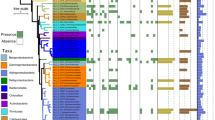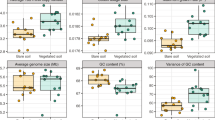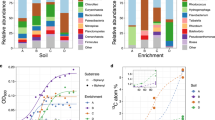Abstract
A new generation of functional gene arrays (FGAs; GeoChip 3.0) has been developed, with ∼28 000 probes covering approximately 57 000 gene variants from 292 functional gene families involved in carbon, nitrogen, phosphorus and sulfur cycles, energy metabolism, antibiotic resistance, metal resistance and organic contaminant degradation. GeoChip 3.0 also has several other distinct features, such as a common oligo reference standard (CORS) for data normalization and comparison, a software package for data management and future updating and the gyrB gene for phylogenetic analysis. Computational evaluation of probe specificity indicated that all designed probes would have a high specificity to their corresponding targets. Experimental analysis with synthesized oligonucleotides and genomic DNAs showed that only 0.0036–0.025% false-positive rates were observed, suggesting that the designed probes are highly specific under the experimental conditions examined. In addition, GeoChip 3.0 was applied to analyze soil microbial communities in a multifactor grassland ecosystem in Minnesota, USA, which showed that the structure, composition and potential activity of soil microbial communities significantly changed with the plant species diversity. As expected, GeoChip 3.0 is a high-throughput powerful tool for studying microbial community functional structure, and linking microbial communities to ecosystem processes and functioning.
Similar content being viewed by others
Log in or create a free account to read this content
Gain free access to this article, as well as selected content from this journal and more on nature.com
or
References
Adriano DC . (2001). Trace Elements in Terrestrial Environments: Biogeochemistry, Bioavailability, and Risks of Metals, 2nd edn. Springer-Verlag: New York.
Ahn S, Costa J, Emanuel J . (1996). PicoGreen quantitation of DNA: effective evaluation of samples pre- or post-PCR. Nucleic Acids Res 24: 2623–2625.
Berg IA, Kockelkorn D, Buckel W, Fuchs G . (2007). A 3-hydroxypropionate/4-hydroxybutyrate autotrophic carbon dioxide assimilation pathway in Archaea. Science 318: 1782–1786.
Bodrossy L, Sessitsch A . (2004). Oligonucleotide microarrays in microbial diagnostics. Curr Opin Microbiol 7: 245–254.
Brodie EL, Desantis TZ, Joyner DC, Baek SM, Larsen JT, Andersen GL et al. (2006). Application of a high-density oligonucleotide microarray approach to study bacterial population dynamics during uranium reduction and reoxidation. Appl Environ Microbiol 72: 6288–6298.
Brodie EL, DeSantis TZ, Parker JP, Zubietta IX, Piceno YM, Andersen GL . (2007). Urban aerosols harbor diverse and dynamic bacterial populations. Proc Natl Acad Sci USA 104: 299–304.
Calvin M . (1961). Quantum conversion in photosynthesis. J Theor Biol 1: 258–287.
Dix DJ, Gallagher K, Benson WH, Groskinsky BL, McClintock JT, Dearfield KL et al. (2006). A framework for the use of genomics data at the EPA. Nat Biotechnol 24: 1108–1111.
Eddy SR . (1998). Profile hidden Markov models. Bioinformatics 14: 755–763.
Eisen MB, Spellman PT, Brown PO, Botstein D . (1998). Cluster analysis and display of genome-wide expression patterns. Proc Natl Acad Sci USA 95: 14863–14868.
Ellis LB, Roe D, Wackett LP . (2006). The University of Minnesota Biocatalysis/Biodegradation Database: the first decade. Nucleic Acids Res 34: D517–D521.
Evans MC, Buchanan BB, Arnon DI . (1966). New cyclic process for carbon assimilation by a photosynthetic bacterium. Science 152: 673.
Gans J, Wolinsky M, Dunbar J . (2005). Computational improvements reveal great bacterial diversity and high metal toxicity in soil. Science 309: 1387–1390.
HazDat. (2007). Agency for Toxic Substances and Disease Registry (ATSDR). http://www.atsdr.cdc.gov/cercla/07list.html.
He Z, Gentry TJ, Schadt CW, Wu L, Liebich J, Chong SC et al. (2007). GeoChip: a comprehensive microarray for investigating biogeochemical, ecological and environmental processes. ISMEJ 1: 67–77.
He Z, Wu L, Li X, Fields MW, Zhou J . (2005). Empirical establishment of oligonucleotide probe design criteria. Appl Environ Microbiol 71: 3753–3760.
He Z, Xu M, Deng Y, Kang S, Kellogg L, Wu L et al. (2010). Metagenomic analysis reveals a marked divergence in the structure of belowground microbial communities at elevated CO2 . Ecol Lett 13: 564–575.
Herter S, Busch A, Fuchs G . (2002). L-Malyl-coenzyme A lyase/beta-methylmalyl-coenzyme A lyase from Chloroflexus aurantiacus, a bifunctional enzyme involved in autotrophic CO2 fixation. J Bacteriol 184: 5999–6006.
Kimes NE, Van Nostrand JD, Weil E, Zhou J, Morris PJ . (2010). Microbial functional structure of Montastraea faveolata, an important Caribbean reef-building coral, differs between healthy and yellow-band diseased colonies. Environ Microbiol 12: 541–556.
Leigh MB, Pellizari VH, Uhlik O, Sutka R, Rodrigues J, Ostrom NE et al. (2007). Biphenyl-utilizing bacteria and their functional genes in a pine root zone contaminated with polychlorinated biphenyls (PCBs). ISMEJ 1: 134–148.
Li X, He Z, Zhou J . (2005). Selection of optimal oligonucleotide probes for microarrays using multiple criteria, global alignment and parameter estimation. Nucleic Acids Res 33: 6114–6123.
Liang Y, He Z, Wu L, Deng Y, Li G, Zhou J . (2010). Development of a common oligo reference standard (CORS) for microarray data normalization and comparison across different microbial communities. Appl Environ Microbiol 76: 1088–1094.
Liang Y, Li G, Van Nostrand JD, He Z, Wu L, Deng Y et al. (2009). Microarray-based analysis of microbial functional diversity along an oil contamination gradient in oil field. FEMS Microbiol Ecol 70: 324–333.
Liebich J, Schadt CW, Chong SC, He Z, Rhee SK, Zhou J . (2006). Improvement of oligonucleotide probe design criteria for functional gene microarrays in environmental applications. Appl Environ Microbiol 72: 1688–1691.
Ljungdahl LG . (1984) In: Blakely RL, Benkovic SJ (eds). Folates and Pterins. Wiley-Interscience: New York, pp 555–579.
Ljungdahl LG . (1986). The autotrophic pathway of acetate synthesis in acetogenic bacteria. Annu Rev Microbiol 40: 415–450.
Loy A, Lehner A, Lee N, Adamczyk J, Meier H, Ernst J et al. (2002). Oligonucleotide microarray for 16S rRNA gene-based detection of all recognized lineages of sulfate-reducing prokaryotes in the environment. Appl Environ Microbiol 68: 5064–5081.
Mackenzie RE . (1984) In: Blakely RL, Benkovic SJ (eds). Folates and Pterins. Wiley-Interscience: New York, pp 255–306.
Margulies M, Egholm M, Altman WE, Attiya S, Bader JS, Bemben LA et al. (2005). Genome sequencing in microfabricated high-density picolitre reactors. Nature 437: 376–380.
Mason OU, Di Meo-Savoie CA, Van Nostrand JD, Zhou J, Fisk MR, Giovannoni SJ . (2009). Prokaryotic diversity, distribution, and insights into their role in biogeochemical cycling in marine basalts. ISMEJ 3: 231–242.
Meyer B, Kuever J . (2007). Molecular analysis of the diversity of sulfate-reducing and sulfur-oxidizing prokaryotes in the environment, using aprA as functional marker gene. Appl Environ Microbiol 73: 7664–7679.
Nies DH . (2003). Efflux-mediated heavy metal resistance in prokaryotes. FEMS Microbiol Rev 27: 313–339.
Ragsdale SW . (1991). Enzymology of the acetyl-CoA pathway of CO2 fixation. Crit Rev Biochem Mol Biol 26: 261–300.
Reich PB . (2009). Elevated CO2 reduces losses of plant diversity caused by nitrogen deposition. Science 326: 1399–1402.
Reich PB, Knops J, Tilman D, Craine J, Ellsworth D, Tjoelker M et al. (2001). Plant diversity enhances ecosystem responses to elevated CO2 and nitrogen deposition. Nature 410: 809–812.
Rhee SK, Liu X, Wu L, Chong SC, Wan X, Zhou J . (2004). Detection of genes involved in biodegradation and biotransformation in microbial communities by using 50-mer oligonucleotide microarrays. Appl Environ Microbiol 70: 4303–4317.
Rodriguez-Martinez EM, Perez EX, Schadt CW, Zhou J, Massol-Deya AA . (2006). Microbial diversity and bioremediation of a hydrocarbon-contaminated aquifer (Vega Baja, Puerto Rico). Int J Environ Res Public Health 3: 292–300.
Silver S . (1996). Bacterial resistances to toxic metal ions--a review. Gene 179: 9–19.
Silver S, Phung LT . (2005). A bacterial view of the periodic table: genes and proteins for toxic inorganic ions. J Ind Microbiol Biotechnol 32: 587–605.
Stepanauskas R, Gless T, Jagoe C, Tuckfield RC, Lindell A, McArthur JV . (2005). Elevated microbial tolerance to metals and antibiotics in metal-contaminated industrial environments. Environ Sci Technol 39: 3671–3678.
Steward GF, Jenkins BD, Ward BB, Zehr JP . (2004). Development and testing of a DNA macroarray to assess nitrogenase (nifH) gene diversity. Appl Environ Microbiol 70: 1455–1465.
Taroncher-Oldenburg G, Griner EM, Francis CA, Ward BB . (2003). Oligonucleotide microarray for the study of functional gene diversity in the nitrogen cycle in the environment. Appl Environ Microbiol 69: 1159–1171.
Tas N, van Eekert MH, Schraa G, Zhou J, de Vos WM, Smidt H . (2009). Tracking functional guilds: ‘Dehalococcoides’ spp. in European river basins contaminated with hexachlorobenzene. Appl Environ Microbiol 75: 4696–4704.
Tiquia SM, Wu L, Chong SC, Passovets S, Xu D, Xu Y et al. (2004). Evaluation of 50-mer oligonucleotide arrays for detecting microbial populations in environmental samples. Biotechniques 36: 664–670.
Torsvik V, Ovreas L, Thingstad TF . (2002). Prokaryotic diversity—magnitude, dynamics, and controlling factors. Science 296: 1064–1066.
Van Nostrand JD, Wu WM, Wu L, Deng Y, Carley J, Carroll S et al. (2009). GeoChip-based analysis of functional microbial communities during the reoxidation of a bioreduced uranium-contaminated aquifer. Environ Microbiol 11: 2611–2626.
Waldron PJ, Wu L, Van Nostrand JD, Schadt CW, He Z, Watson DB et al. (2009). Functional gene array-based analysis of microbial community structure in groundwaters with a gradient of contaminant levels. Environ Sci Technol 43: 3529–3534.
Wang L, Lee F, Tai C, Kasai H . (2007). Comparison of gyrB gene sequences, 16S rRNA gene sequences and DNA-DNA hybridization in the Bacillus subtilis group. Intl J Syst Evol Microbiol 57: 1846–1850.
Wang F, Zhou H, Meng J, Peng X, Jiang L, Sun P et al. (2009). GeoChip-based analysis of metabolic diversity of microbial communities at the Juan de Fuca Ridge hydrothermal vent. Proc Natl Acad Sci USA 106: 4840–4845.
Whitman WB, Coleman DC, Wiebe WJ . (1998). Prokaryotes: the unseen majority. Proc Natl Acad Sci USA 95: 6578–6583.
Wu L, Kellogg L, Devol AH, Tiedje JM, Zhou J . (2008). Microarray-based characterization of microbial community functional structure and heterogeneity in marine sediments from the Gulf of Mexico. Appl Environ Microbiol 74: 4516–4529.
Wu L, Liu X, Schadt CW, Zhou J . (2006). Microarray-based analysis of subnanogram quantities of microbial community DNAs by using whole-community genome amplification. Appl Environ Microbiol 72: 4931–4941.
Wu L, Thompson DK, Li G, Hurt RA, Tiedje JM, Zhou J . (2001). Development and evaluation of functional gene arrays for detection of selected genes in the environment. Appl Environ Microbiol 67: 5780–5790.
Yamamoto S, Harayama S . (1995). PCR amplification and direct sequencing of gyrB genes with universal primers and their application to the detection and taxonomic analysis of Pseudomonas putida strains. Appl Environ Microbiol 61: 1104–1109.
Yamamoto S, Harayama S . (1998). Phylogenetic analysis of Pseudomonas putida strains deduced from the nucleotide sequences of gyrB, rpoD, and 16S rRNA genes. Int J Syst Bacteriol 46: 813–819.
Yergeau E, Kang S, He Z, Zhou J, Kowalchuk GA . (2007). Functional microarray analysis of nitrogen and carbon cycling genes across an Antarctic latitudinal transect. ISMEJ 1: 163–179.
Zhang Z, Schwartz S, Wagner L, Miller W . (2000). A greedy algorithm for aligning DNA sequences. J Comput Biol 7: 203–214.
Zhou J . (2009). Predictive microbial ecology. Microb Biotechnol 2: 154–156.
Zhou J, Kang S, Schadt CW, Garten Jr CT . (2008). Spatial scaling of functional gene diversity across various microbial taxa. Proc Natl Acad Sci USA 105: 7768–7773.
Zhou J, Bruns MA, Tiedje JM . (1996). DNA recovery from soils of diverse composition. Appl Environ Microbiol 62: 316–322.
Acknowledgements
This work is supported by the Genomics:GTL program through the Virtual Institute of Microbial Stress and Survival (VIMSS; http://vimss.lbl.gov) as part of contract no. DE-AC02–05CH11231 between the US Department of Energy and Lawrence Berkeley National Laboratory, the United States Department of Agriculture (Project 2007–35319–18305) through NSF-USDA Microbial Observatories Program, the Environmental Remediation Science Program, the Oklahoma Bioengery Center (OBC) of State of Oklahoma, and the Oklahoma Applied Research Support (OARS), Oklahoma Center for the Advancement of Science and Technology (OCAST), the State of Oklahoma.
Author information
Authors and Affiliations
Corresponding author
Additional information
Supplementary Information accompanies the paper on The ISME Journal website
Supplementary information
Rights and permissions
About this article
Cite this article
He, Z., Deng, Y., Van Nostrand, J. et al. GeoChip 3.0 as a high-throughput tool for analyzing microbial community composition, structure and functional activity. ISME J 4, 1167–1179 (2010). https://doi.org/10.1038/ismej.2010.46
Received:
Revised:
Accepted:
Published:
Issue date:
DOI: https://doi.org/10.1038/ismej.2010.46
Keywords
This article is cited by
-
Climate warming enhances microbial network complexity and stability
Nature Climate Change (2021)
-
The role of biocrusts in nitrogen cycling on the tropical reef islands, South China Sea
Acta Oceanologica Sinica (2021)
-
The diversity and metabolic potential of the microbial functional gene associated with Porites pukoensis
Ecotoxicology (2021)
-
Climate mediates continental scale patterns of stream microbial functional diversity
Microbiome (2020)
-
Continental scale structuring of forest and soil diversity via functional traits
Nature Ecology & Evolution (2019)



